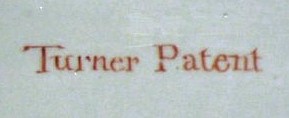 The illustrious firm of Turner was founded by John Turner the elder, born at Newport Shropshire in 1737, who was apprenticed to Daniel Bird of Stoke in 1753; by 1759 he was in a partnership with William Banks at Stoke and shortly after was in business on his own account at Lane End, founding a firm which survived until after the turn of the 19th century.[1]
The illustrious firm of Turner was founded by John Turner the elder, born at Newport Shropshire in 1737, who was apprenticed to Daniel Bird of Stoke in 1753; by 1759 he was in a partnership with William Banks at Stoke and shortly after was in business on his own account at Lane End, founding a firm which survived until after the turn of the 19th century.[1]
John the elder died at the age of 50 in 1787 and the firm was continued by his two sons William and John the younger. The principal products were creamware and stoneware of very high quality; the firm had a substantial trade with continental Europe which was adversely affected by the onset of the French Revolution. Although there are conflicting accounts of the date, it seems that whilst France was in turmoil William travelled there in an attempt to collect some debts and was fortunate to escape with his life. Any financial problems do not appear to have affected the quality of the firm’s output. Creamwares and stonewares of the highest quality were made throughout the 1790s and there are documented references to the manufacture of porcelain in 1800 and dissension within the industry in the same year by their patenting of the use of Tabberner’s Mine Rock. [2]
The first documentary references which suggest partnership disputes or financial difficulties date to the first few years of the nineteenth century; in 1803, the Turner brothers took into partnership their brother-in-law John Glover and Charles Simpson, who had been confidential clerk to John Turner the elder. John Turner retired from the partnership in 1804 was subsequently employed by Mintons in a managerial capacity. The two brothers were adjudicated bankrupt in August 1806 but William was able to recommence business on his own account at another location, finally retiring in 1829.[3]
Blue printed wares do not seem to have been a prominent part of the firm’s output. Early examples are limited to a few patterns. A very rare platter in a ‘Bridge and Willow’ pattern[4] features a large area devoid of decoration, suggesting a date as early as the 1780s. Other early patterns are ‘The Elephant’ and ‘The Stag Hunt’, the latter being by far the most common, but these are more typical of the 1790s. Another blue printed pattern, a bridgeless version of ‘Willow’ is often of indifferent quality, suggesting a product of the factory’s declining years, or perhaps of William’s post bankruptcy operations.[5]
For printed wares in the exhibit by William & John Turner click here
For printed wares in the exhibit by William Turner click here
[2] See ‘The Turners of Lane End’ by Bevis Hillier, Cory, Adams and Mackay 1965, Chapter 3 and notes thereto.
[3] Hillier, ibid, Chapter 9 and notes thereto.
[4] Illustrated at Case 23/6 of ‘True Blue’, Friends of Blue Exhibition Catalogue 1998. The other three patterns mentioned are all illustrated in the Transferware Collectors’ Club Database.
[5] The ‘Staffordshire Advertiser’ notice of William’s closing down sale on 12th December 1829 refers to copper plate engravings of ‘Willow table service’.
